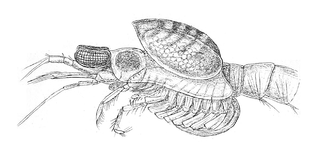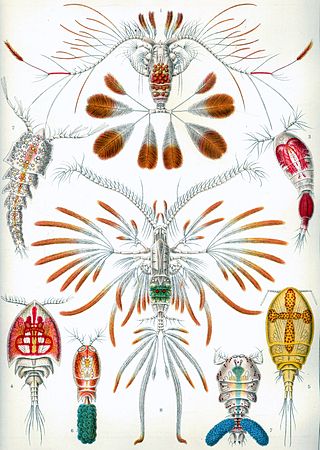
Tantulocarida is a highly specialised group of parasitic crustaceans that consists of about 33 species, treated as a class in superclass Multicrustacea. They are typically ectoparasites that infest copepods, isopods, tanaids, amphipods and ostracods.

Siphonostomatoida is an order of copepods, containing around 75% of all the copepods that parasitise fishes. Their success has been linked to their possession of siphon-like mandibles and of a "frontal filament" to aid attachment to their hosts. Most are marine, but a few live in fresh water. There are 40 recognised families:

Lottiidae is a family of sea snails, specifically true limpets, marine gastropod mollusks in the superfamily Lottioidea and the clade Patellogastropoda.
The World Register of Marine Species (WoRMS) is a taxonomic database that aims to provide an authoritative and comprehensive list of names of marine organisms.
Stygotantulus is a genus of crustacean with the sole species Stygotantulus stocki. It lives as an ectoparasite on harpacticoid copepods of the families Tisbidae and Canuellidae. It is the smallest arthropod in the world, at a length of less than 0.1 millimetres (0.004 in). The specific name stocki commemorates Jan Hendrik Stock, a Dutch carcinologist. Another contender for the world's smallest arthropod is Tantulacus dieteri, with a total body length of only 85 micrometres (0.0033 in).

The Bopyridae are a family of isopod crustaceans in the suborder Cymothoida. There are 1223 individual species contained in this family. Members of the family are ectoparasites of crabs and shrimp. They live in the gill cavities or under the carapace where they cause a noticeable swelling. Fossil crustaceans have occasionally been observed to have a similar characteristic bulge.
Cancricepon is a genus of isopod crustaceans in the family Bopyridae. It has been synonymised with Merocepon Richardson, 1910.

The Cryptoniscidae are a family of isopod crustaceans in the suborder Cymothoida. The original description was made by Kossmann in 1880. "Liriopsidae" is a junior synonym. Members of this family are hyperparasites of rhizocephalid barnacles which are themselves parasites of decapod crustaceans. The morphology of the adult females gives little clue as to their true identity, but the free-living larvae show their true taxonomic affiliations.

The Dajidae are a family of marine isopod crustaceans in the suborder Cymothoida. The original description was made by Giard and Bonnier in 1887. Members of this family are ectoparasites of krill. They resemble a fleshy growth on the krill's back, and make the host look as if it is wearing a rucksack. These genera are included in the family Dajidae:
Nicothoidae is a family of copepods, containing the following genera:
Parasymmetrorbione is a genus of isopod containing a single species, Parasymmetrorbione bicauda.
Mucronalia is a genus of very small parasitic sea snails, marine gastropod mollusks or micromollusks in the family Eulimidae.

Harriet Richardson Searle was an American carcinologist. She was known as the first lady of isopods and was one of the first female carcinologists, with only Mary Jane Rathbun before her.

Artotrogidae is a family of copepods in the order Siphonostomatoida.

The clade Multicrustacea constitutes the largest superclass of crustaceans, containing approximately four-fifths of all described crustacean species, including crabs, lobsters, crayfish, shrimp, krill, prawns, woodlice, barnacles, copepods, amphipods, mantis shrimp and others. The largest branch of multicrustacea is the class Malacostraca.

The Hexanauplia is a clade proposed by Oakley et al. (2013) that constitutes a class of crustaceans, comprising the Copepoda and Thecostraca. A number of recent phylogenomic studies have not found support for this clade.
Allorbimorphus is a genus of Isopoda parasites, in the family Bopyridae, containing the following species that can be found on the coasts of Australia, and Asia:
Doryphallophoridae is a family of crustaceans belonging to the class Tantulocarida. The family was previously placed in class Hexanauplia.
Microdajidae is a family of crustaceans belonging to the class Tantulocarida. The family was previously place in class Hexanauplia.
Aporobopyrus is a genus of Isopoda parasites, in the family Bopyridae, that contains the following 20 species:









